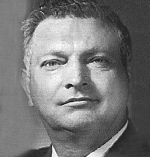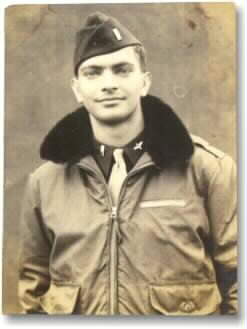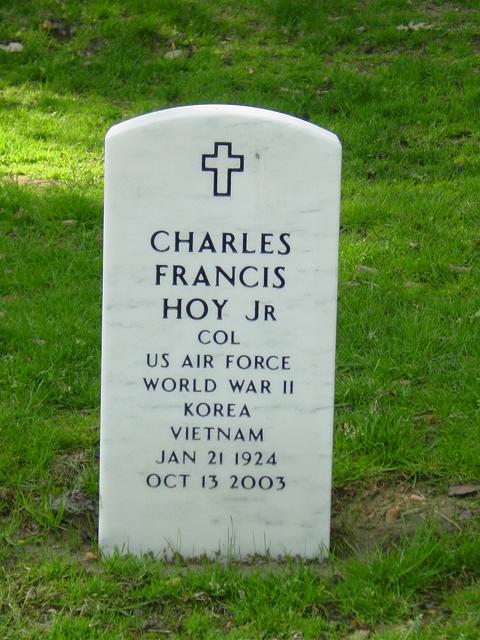Colonel Charles F. Hoy, Jr., United States Air force (retired) of Melbourne, Florida, age 79, passed away on Monday, October 13, 2003.
Colonel Hoy was born in Charleston, West Virginia. He had a distinguished Military career. He was with the 34th Photo Reconnaissance Squadron during World War II and after receiving a regular commission in 1946, he continued in photo reconnaissance.
He served with distinction, returning from a combat tour in Korea and serving during Vietnam; ARDC HQ in Baltimore; was involved in the development of the U-2 and SR-71; assigned to the Central Intelligence Agency (CIA) and Defense Intelligence Agency (DIA) in turn and retired from the National Reconnaissance Office (NRO) in 1971 after 30 years of service.
Colonel Hoy's service awards include: Legion of Merit (with cluster); Distinguished Flying Cross, Air Medal with 8 clusters, Joint Service Commendation Medal and Air Force Commendation Medal. After the end of the Cold War, Colonel Hoy was recognized as a pioneer and awarded the prestigious Space Pioneers Medal.
He is survived by his daughter, Wendy Reader of Melbourne, Florida; son, James Hoy of Palm Bay, Florida; companion, Alexandra Wanman; brother, Jack Hoy of Edgefield, South Carolina; grandson, Christopher Hoy Ennis; and great-grandson, Tyler Ennis.
Burial will be in Arlington National Cemetery on January 5, 2004 at 11 a.m.
Donations can be made to the American Heart Association.
Now that I am gone from here
please do not grieve for me.
Let there be no sorrow,
life must go on you see.
Remember me always,
The good times that we've had
Our life it had its ups and downs
but it wasn't all that bad.
Time will pass so quickly
but time will heal the wounds.
The memories will last forever
and the pain will leave you soon.
Memories are forever,
I thank you for the love we've shared
And I'll be waiting for you
when you climb the Golden Stairs.
In 1970, retired U.S. Air Force Col. Charles F. Hoy Jr. assumed that the chest pain he had been having was heartburn. He was wrong.
Hoy was experiencing severe angina. He managed to stay on active duty about a year after first experiencing angina by working half days and being careful. He usually took two nitroglycerin tablets to get from the Pentagon parking lot to the office.
“It was nice when I could start the day at a quiet meeting elsewhere and get to the office late, thus avoiding the stress of the morning traffic, but that often meant that I had to walk an extra distance from the massive parking area. Sometimes you can't win,” says Hoy.
After a year, Hoy was given a medical discharge because of his heart disease. He remained on medication for 12 years after retiring to a quiet spot in Florida near Patrick Air Force Base. In May 1980, a complication, type II diabetes, joined his ever-increasing array of health problems.
In 1982, Hoy had another attack of severe angina while on a trip west visiting old friends in San Antonio. Bypass surgery was now available. A new treatment called angioplasty, not approved by Medicare was also available. After he was stabilized, his physician said he could get Hoy back on the road in three days by performing angioplasty rather than bypass, which required a long hospital stay. Hoy immediately agreed to an angioplasty.
After the angioplasty, relief from chest pain lasted about a year, but then he was back on nitroglycerin tablets again. Another angiogram revealed that he had at least three serious blockages around the heart, and three aneurysms in the aorta. Hoy underwent bypass surgery, and two months later his vascular surgeon gave him a new plastic aorta.
This year he had planned a dream vacation to four Hawaiian islands. A pre-vacation checkup revealed that Hoy's blood sugar and triglycerides were elevated, and he did not do well on the stress test. An angiogram showed that two of his five bypasses were blocked (one 100 percent, the other, 70 percent). Not able to undergo another angioplasty, he was given a strict diet and new medications.
Just one week before his scheduled departure for Hawaii, he had to take two nitroglycerin tablets and finally, a third. When the pain didn't diminish he knew he was in trouble. He was admitted to intensive care and treated for full-blown congestive heart failure. The cardiologist on call confirmed he was not a candidate for invasive treatment and recommended EECP® treatment.
After receiving EECP® treatment, Hoy resigned himself to careful control of his diet and exercise for the rest of his life. He entered a rehabilitation exercise program where he rides a stationary bike for 30 minutes, lifts weights, and does other exercises that would have been impossible before. “I am free of angina without having had an operation of any kind! The good news is that I've lost 35 pounds; the bad news is that my pants are too big! I feel fine and ready to get back into our travel program,” says Hoy.
HOY, CHARLES FRANCIS JR
- COL US AIR FORCE
- VETERAN SERVICE DATES: 06/24/1942 – 05/03/2003
- DATE OF BIRTH: 01/21/1924
- DATE OF DEATH: 10/31/2003
- DATE OF INTERMENT: 01/05/2004
- BURIED AT: SECTION 30 SITE 1145-LH
ARLINGTON NATIONAL CEMETERY
HOY, DORIS ADELE
- DATE OF BIRTH: 08/08/1923
- DATE OF DEATH: 09/23/1955
- DATE OF INTERMENT: 09/27/1955
- BURIED AT: SECTION 30 SITE 1145-RH
- ARLINGTON NATIONAL CEMETERY
- WIFE OF HOY, CHARLES FRANCIS JR COL US AIR FORCE
Michael Robert Patterson was born in Arlington and is the son of a former officer of the US Army. So it was no wonder that sooner or later his interests drew him to American history and especially to American military history. Many of his articles can be found on renowned portals like the New York Times, Washingtonpost or Wikipedia.
Reviewed by: Michael Howard



